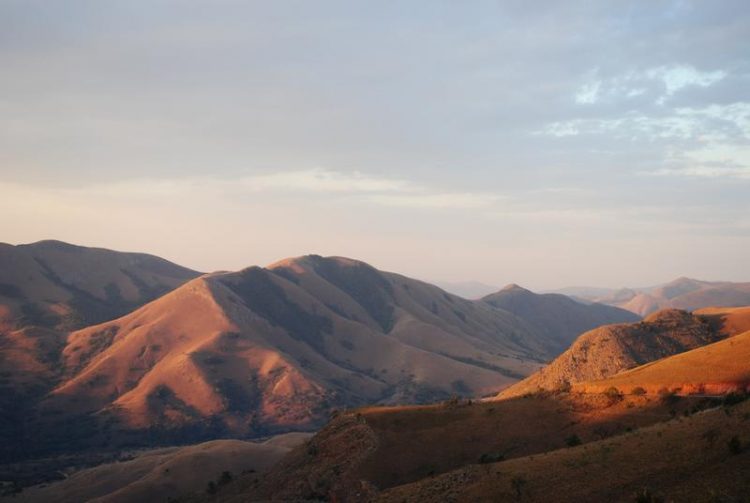Life took hold on land 300 million years earlier than thought

The Barberton Mountains in northeastern South Africa are covered by rocky grasslands; these hills are made of some of the oldest rocks on Earth (3.2 - 3.5 billion years old). Picture: Sami Nabhan/FSU Jena
In a layer that has been dated at 3.22 billion years old, tiny grains of the iron sulfide mineral pyrite were discovered that show telltale signs of microbial activity. These signs are recorded both in trace element distributions as well as in the ratio between the sulfur isotopes 34S and 32S in the pyrite.
Using instrumentation installed in Potsdam in 2013, the scientists showed that the fraction of 34S in the core of some crystals differ characteristically from that of the same crystal’s rim, indicating that the exterior of the grain involved a processing of sulfur by microbes, so-called biogenic fractionation.
The determination of the 34S/32S ratio, using sample masses less than one billionth of a gram, was carried out at the GFZ German Research Centre for Geosciences by Michael Wiedenbeck of the GFZ’s secondary ion mass spectrometry (SIMS) lab.
The composition of the rock, the shape of the crystals, and the layering visible in the field all indicate that the studied rock sequence was derived from an ancient soil profile; this so-called paleosol developed on a river flood plain 3.22 billion years ago.
Field data collected during this study imply that a braided river system transported the sediment containing the iron sulfide crystals. It is interpreted that microbes living in the soil, at a level that was continually shifting between wet and dry conditions, subsequently produced the rim overgrowths on the pyrite crystals.
Based on this evidence, the scientists conclude in their publication in the journal “Geology” that they found evidence for biological activity on land at this very early date. Their research pushes back the date for the oldest evidence of life on land to some 300 million years earlier than previously documented.
Title of the study: Sami Nabhan, Michael Wiedenbeck, Ralf Milke and Christoph Heubeck: Biogenic overgrowth on detrital pyrite in ca. 3.2 Ga Archean paleosols. In: Geology, vol. 44, No. 9 (DOI: 10.1130/G38090.1)
Media Contact
More Information:
http://www.gfz-potsdam.de/All latest news from the category: Earth Sciences
Earth Sciences (also referred to as Geosciences), which deals with basic issues surrounding our planet, plays a vital role in the area of energy and raw materials supply.
Earth Sciences comprises subjects such as geology, geography, geological informatics, paleontology, mineralogy, petrography, crystallography, geophysics, geodesy, glaciology, cartography, photogrammetry, meteorology and seismology, early-warning systems, earthquake research and polar research.
Newest articles

First-of-its-kind study uses remote sensing to monitor plastic debris in rivers and lakes
Remote sensing creates a cost-effective solution to monitoring plastic pollution. A first-of-its-kind study from researchers at the University of Minnesota Twin Cities shows how remote sensing can help monitor and…

Laser-based artificial neuron mimics nerve cell functions at lightning speed
With a processing speed a billion times faster than nature, chip-based laser neuron could help advance AI tasks such as pattern recognition and sequence prediction. Researchers have developed a laser-based…

Optimising the processing of plastic waste
Just one look in the yellow bin reveals a colourful jumble of different types of plastic. However, the purer and more uniform plastic waste is, the easier it is to…



